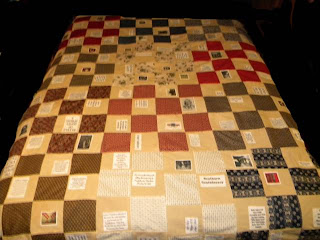Civil War Replica
Here is a fun quilt that I'm making possibly for inclusion at a Cherokee Nation facility. Legislation passed into the Cherokee Nation Code states that when buildings are constructed, a percentage of the budget is for Cherokee art.
I'm a Cherokee history buff. This quilt is interesting because I've utilized replica fabrics which existed during the Civil War era. See how the colors of red are turkey red? See how there are two shades of blue... conrflower blue and indigo? See how the green is more of a bronze color? Greens back then were made in a two-stage process where indigo was overdyed with something producing a yellow. Greens were transient colors, and if you ever look inside the seam of an old quilt, you can see what the original color more closely resembled.
The cream "blank" squares are natural unbleached muslin, but I then overdyed them with a camel color to sadden the fabric and give an aged appearance. A quilt from the 1860s, now 150 years old, would not remain this bright. Beth Herrington has a quilt from this time period, which was once featured in a Thompson House quilt show about 15 years ago. It was a quilt that a soldier had carried with him in the war.
This one consists of four four-patches grouped together. And while I have never seen a 16-patch, it is typical because it is geometric, pieced, contains squares of about four inches. The sewing machine was invented or sold about 1824 or so--- it is a contemporary of photography and the industrial revolution in England. But very few homes had treadle machines and almost all sewing was by hand. This one was machine pieced (and when quilted, it will be machine quilted). Unlike quilts from the 1860s, this one is retrospective. The squares contain images (such as quilt block patterns) from the Civil War era, and also facts and information about the Cherokee condition in the Civil War. Most of the facts were gleaned from Emmet Starr's History of the Cherokee Indians. You would find the last names of some of the soldiers who fought together; some names of battles in Cherokee Nation, Indian Territory; information about impacts of the war; and some quotations; treaties; casualty summaries, and the like.
When I made this quilt before I added the war data, it seemed too new to be authentic and didn't tell much of a story except via colors. Now with the fact squares, it 'speaks' about its historical context. I'll be posting more Cherokee art quilts of this nature in the future from time to time.
I am seeking a Cherokee hand-quilter who would like to collaborate on this project, but my time frame is short. If you would be interested in hand-quilting it (or know of someone who does that), then I would be delighted to hear from you.





My email: ktibbits@lrec.org
ReplyDelete